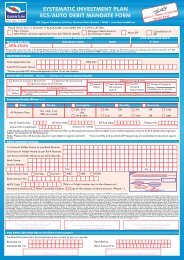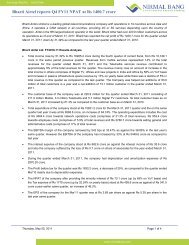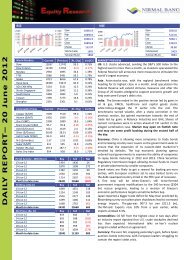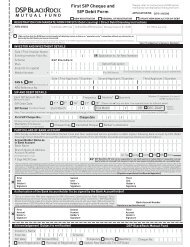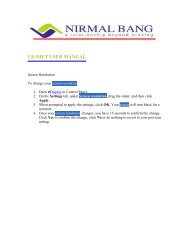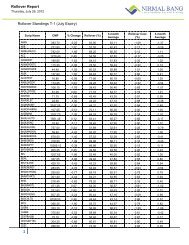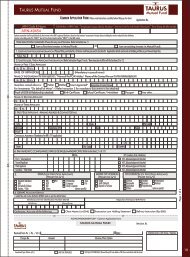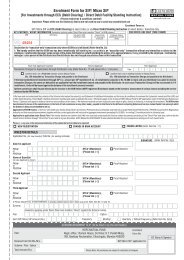Institutional Equities - Online Share Trading
Institutional Equities - Online Share Trading
Institutional Equities - Online Share Trading
Create successful ePaper yourself
Turn your PDF publications into a flip-book with our unique Google optimized e-Paper software.
<strong>Institutional</strong> <strong>Equities</strong><br />
Key operational issues in power sector and our view<br />
Mounting losses of SEBs denting power demand<br />
State electricity boards’ (SEBs) losses have almost doubled from US$6bn to US$12bn in the past three years<br />
due to increase in the spread between average cost of supply and average power tariff and T&D (transmission<br />
and distribution) losses. This has led to lower demand from SEBs for merchant power at a higher price.<br />
Recently, the government passed a resolution to arrest and reverse growing losses of SEBs. As per the<br />
resolution, SEB loans will be converted into equity to improve their networth, pass-through of any increase in<br />
power purchase costs, state governments to release subsidies to discoms for ‘below cost’ power supply to<br />
agriculture and rural households in advance and opening up of discoms for competition through input-based<br />
distribution franchisee system. We believe the worst is over for SEBs and going forward, their finances will<br />
gradually improve due to increased power availability via long-term contracts, tariff hike and lower T&D losses.<br />
Exhibit 45: Yawning gap between ACS, ARR<br />
Rs/unit FY07 FY08 FY09<br />
Average cost of supply(ACS) 2.76 2.93 3.4<br />
Average revenue realised(ARR) 2.27 2.39 2.62<br />
Revenue GAP (0.49) (0.54) (0.78)<br />
Gap with subsidy 0.25 0.23 0.33<br />
Gap on revenue and subsidy realised basis 0.34 0.35 0.6<br />
Source: PFC, Nirmal Bang <strong>Institutional</strong> <strong>Equities</strong> Research<br />
Exhibit 46: SEBs’ losses<br />
FY07 FY08 FY09<br />
Power distribution companies (Rsbn)<br />
Total income (excluding subsidy) 1,319 1,495 1,704<br />
Total expenditure 1,599 1,836 2,213<br />
PAT (without subsidy) (279) (342) (506)<br />
PAT (with subsidy) (151) (178) (322)<br />
Subsidy received 128 165 184<br />
Subsidy as a percentage of revenue (%) 9.7 11.0 10.8<br />
Subsidy booked 136 195 297<br />
Subsidy as a percentage of revenue booked (%) 10.3 13.0 17.4<br />
Genco, transmission and trading P&L A/c (Rsbn)<br />
Total income (excluding subsidy) 812 862 961<br />
Total expenditure 795 833 974<br />
PAT (without subsidy) 11.6 22.0 (20.0)<br />
PAT (with subsidy) 11.9 22.0 (20.0)<br />
Total SEB losses (Rsbn)<br />
Total income (excluding subsidy) 2,131 2,357 2,665<br />
Total expenditure 2,394 2,669 3,187<br />
PAT (without subsidy) (267) (320) (526)<br />
PAT ( with subsidy) (139) (156) (342)<br />
Total debt (Rs trn) 1.28 1.54 2.4<br />
Source: PFC, Nirmal Bang <strong>Institutional</strong> <strong>Equities</strong> Research<br />
Pressure on merchant power tariff to continue<br />
Merchant power rates primarily depend on the deficit level (difference between demand and short-term power<br />
supply). During 1QFY11, merchant power tariff declined from Rs7-8/unit to Rs3-4/unit (barring assembly<br />
election states) due to decline in the deficit level. As significant power generation growth is expected across<br />
central and state government utilities and the private sector, we expect the base deficit to decline meaningfully<br />
in FY13. Hence, we believe the pressure on merchant rates would continue in future and we have factored in<br />
Rs 4.25/unit for FY12 and Rs 4.00/unit FY13 in our model.<br />
20 Infrastructure Sector




